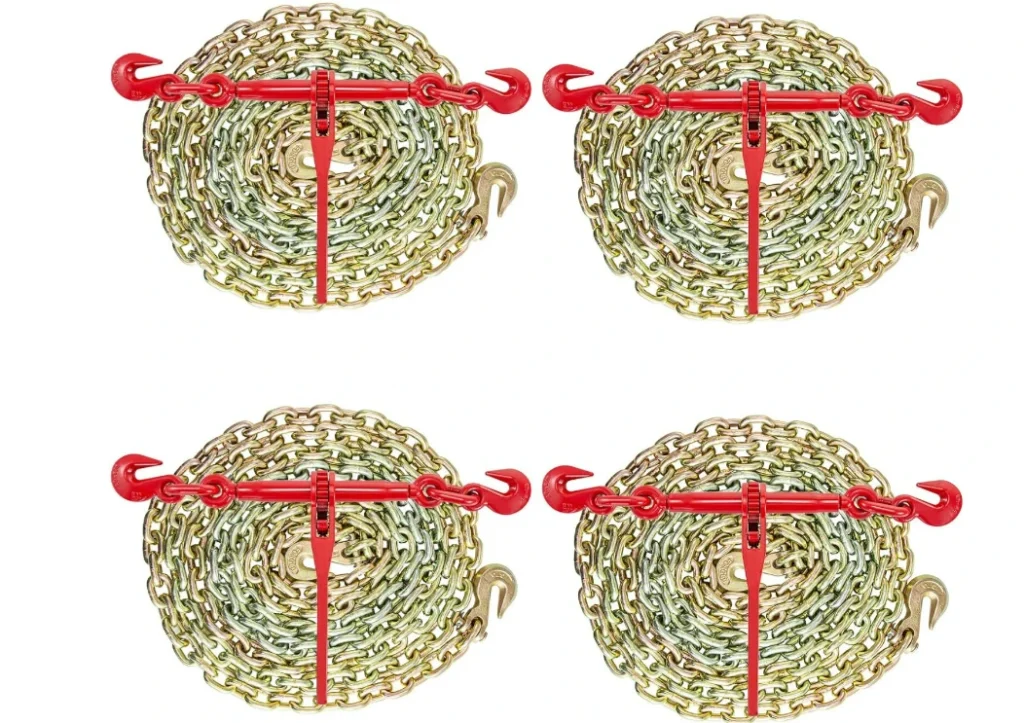If you are looking for a reliable and efficient way to tighten chain when transporting cargo, you need a chain binder. A chain binder, also known as a load binder, is a device that hooks to the end of a chain and applies tension to secure the load. There are two main types of chain binders: lever binders and ratchet binders. In this article, we will explain the differences between them, how to use them safely, and where to buy them online.
Lever Binders vs. Ratchet Binders
Lever binders and ratchet binders are both designed to tighten chain, but they have different mechanisms and advantages. Here is a brief comparison of the two:
- Lever binders use a lever and a tension hook to pull the chain tight. They are simple to operate, but require more physical strength and can be dangerous if the lever snaps back. Lever binders are suitable for short distances and low-speed transportation.
- Ratchet binders use a ratchet and a handle to crank the chain tight. They are easier to use, but take more time and can be difficult to release. Ratchet binders are suitable for long distances and high-speed transportation.
Both types of chain binders have a working load limit (WLL) and a breaking strength (BS) that indicate how much weight they can handle. The WLL is the maximum load that the binder can safely secure, while the BS is the point at which the binder will fail. You should always choose a chain binder that matches the size and grade of your chain, and never exceed the WLL of the binder or the chain.

How to Use Chain Binders Safely
Chain binders are essential tools for load securement, but they can also pose some risks if not used properly. Here are some safety tips to follow when using chain binders:
- Wear gloves, eye protection, and other appropriate personal protective equipment (PPE) when handling chain binders.
- Inspect the chain binders before each use and replace any damaged or worn parts.
- Use the right size and type of chain binder for your chain and load. Check the WLL and BS of the binder and the chain, and make sure they are compatible.
- Use at least two chain binders per load, and distribute them evenly along the length of the load. The angle of the chain should not exceed 45 degrees from the horizontal plane.
- Tighten the chain binders until the chain is snug, but not too tight. Do not over-tighten or under-tighten the chain, as this can cause damage or slippage.
- Secure the excess chain and the handle of the binder to prevent them from swinging or hitting the load or the vehicle.
- Check the chain binders regularly during transportation and re-tighten them if necessary.
- Release the chain binders carefully and slowly, and avoid any sudden movements that can cause the chain or the binder to snap back.
Where to Buy Chain Binders Online
- VEVOR Chain And Binder Kit 3/8In-1/2In, Ratchet Load Binders 9215Lbs Working Strength, Ratchet Binders And Chains, 3/8in X 10ft Chains W/ G70 Hooks, which includes two ratchet binders and two chains with hooks, ideal for heavy-duty applications.
- VEVOR Ratchet Chain Binder, 5/16″-3/8″ Heavy Duty Load Binders, With G80 Hooks 7,100 Lbs Secure Load Limit, Labor-Saving Anti-Skid Handle, Tie Down, which features a ratchet mechanism, a detachable anti-skid handle, and a forged steel construction, suitable for medium-duty applications.
- Towmavin Chain Binder 1/4″ – 5/16″,Working Load Limit With 2600Lbs,For Securing Loads In Chain Binding Applications On Flatbed-2Pack, which offers a lever binder, a spring-loaded pawl, and a heat-treated hook, perfect for light-duty applications.

You can also find other accessories and tools for load securement, such as corner protectors, winch straps, cargo nets, and more. VEVOR offers fast and free shipping, easy returns, and excellent customer service. You can also enjoy discounts and coupons when you shop online at VEVOR.
FAQ
Here are some frequently asked questions and answers about chain binders:
What is the difference between grade 70 and grade 80 chain?
Grade 70 and grade 80 are two common grades of transport chain used for load securement. The grade indicates the strength and quality of the chain. Grade 70 chain is made of carbon steel and has a gold finish. It is designed for tie-down applications and has a WLL of 6,600 lbs for a 3/8 inch chain. Grade 80 chain is made of alloy steel and has a black finish. It is designed for lifting and hoisting applications and has a WLL of 7,100 lbs for a 3/8 inch chain.
How do I know what size chain binder to use?
The size of the chain binder depends on the size and grade of the chain you are using. You should always use a chain binder that matches the chain in terms of WLL and BS. For example, if you are using a 3/8 inch grade 70 chain, you should use a 3/8 inch chain binder with a WLL of at least 6,600 lbs and a BS of at least 26,400 lbs. You can find the size and WLL of the chain and the binder on their labels or markings.
How do I release a ratchet chain binder?
To release a ratchet chain binder, you need to follow these steps:
- Park the vehicle in a safe and level area and apply the brakes.
- Loosen the tension on the chain by pulling the handle of the binder slightly towards the chain.
- Push the pawl of the binder towards the handle and rotate the handle 180 degrees until it locks in the open position.
- Pull the handle away from the chain and unhook the binder from the chain.
- Remove the chain from the load and the vehicle.
